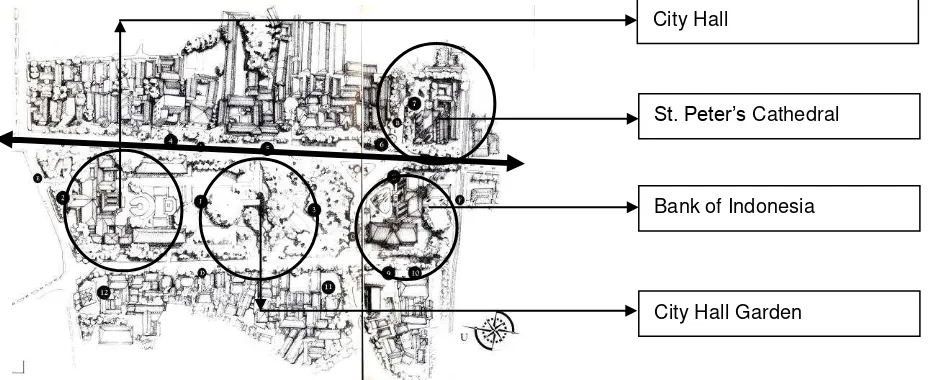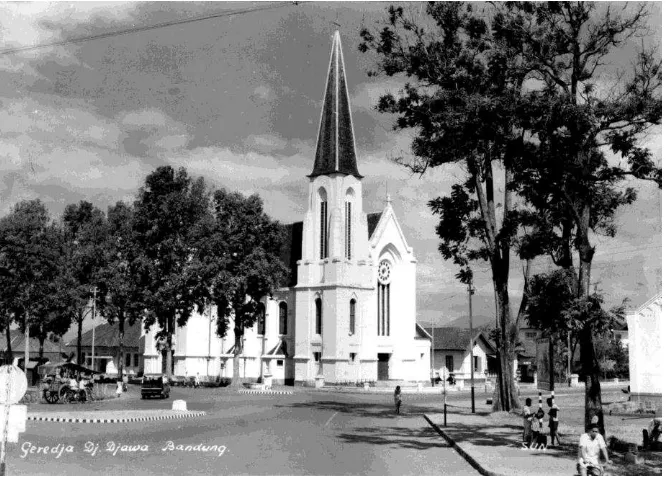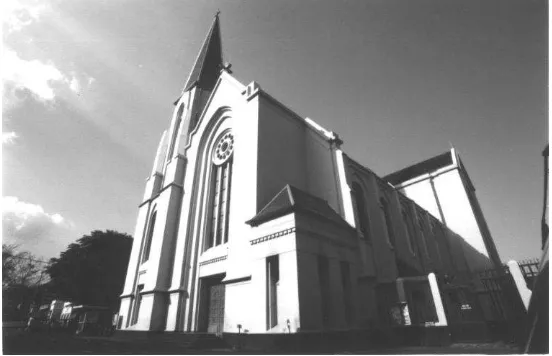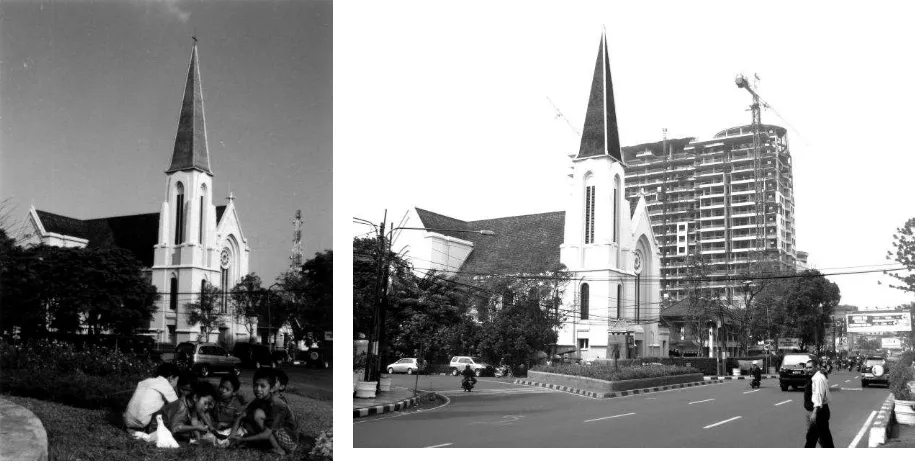The Decreasing Significant Values of St. Peter’s
Cathedral Bandung
KRISMANTO KUSBIANTORO†
Faculty of Art and Design, Maranatha Christian University, Jl. Prof.Drg.Suria Sumantri, MPH no 65 Bandung, 40164 West Java, Indonesia
Email: [email protected]
ABSTRACT
Our world nowadays is inevitably challenged by globalization that put pressure in all aspects of human lives with no exception, including architecture. The fast changing character of globalization directly influences the daily life of the people and also transforms the faces of our modern cities.
Architecture, which is a materialization of certain cognitive systems that is determined by the relationship quality of human beings and their surroundings at a certain period, is facing a problem of sustainability due to these rapid changes. Heritage buildings and historical sites, which happens to be the landmarks of a certain era, are seriously threatened since the significant values are continuously decreasing. It is obvious that places are significant when they have meanings, and places that have meanings will be more sustainable.
St. Peter’s Cathedral in Bandung (West Java, Indonesia) is a heritage building that is now facing such problem. It was built in 1922 and designed by a famous Dutch architect Charles Propper Wolff Schoemaker who designed many other heritage buildings in Bandung. Since the very beginning, the cathedral had become a significant landmark for Bandung due to its vertical expression by an extreme height compared to its surroundings. The cathedral was a significant point at Bandung’s skyline.
But in a few decades, the significant value of this building was continuously decreasing due to fast new buildings construction on its surroundings. Past few years a monumental building as extension wing to Bank of Indonesia appeared exactly in front of the cathedral building. Recently a huge construction of luxurious apartment is being built next to the cathedral. Ironically only a small group of people are concern and realize that the cathedral is facing a problem of significance.
This paper will historically describe how the significant values of the cathedral continuously decreasing and suggest sustainable solutions when it comes to the protection of our built heritages that requires a collaborative effort of the government, urban planners, architects, developers and also academicians.
KEYWORDS
globalization, significant, heritage, cathedral, historical
1. INTRODUCTION
The globalization phenomenon is inevitably challenged our world along with the rapid development of technology. This fast changing development shortened distances and times so that the flow of information, economics, technologies and many other aspects that directly influenced the human lives keeps unstoppably flowing beyond any boundaries. All nations, countries and cultures with no exception, challenged by globalization; including architecture which is a cultural product.
Architecture belief that a form was created for certain purposes. The starting point of architectural practice is the needs and wants that must be contained in a facility. (Salura, 2000: 15-16) Architecture as
a container is actually a materialization of certain cognitive systems that is determined by the relationship quality of human beings and their surroundings at a certain period. (Salura, 2007: 2) These cognitive systems are determined by the spirit of time and inseparable from the global change. Hence architecture is always inseparable from the spirit of time and the global changes.
Historical heritage buildings that represent its spirits of time must face the impact of globalization that includes the changes of values that sometimes irreversible. These values changes are inevitable and potentially able to disturb the sustainability of the heritage buildings.
Many heritage buildings are physically conserved without preserving the values within. We know that buildings are significant when they have meanings. But when the values and the meanings are slightly change due to the globalization challenges, than the significance of the building will gradually decreasing.
This is the phenomenon that occurs at the Church of St. Peter’s Cathedral Bandung. This building is one of the most important historical landmarks of Bandung. Although it is categorized as one of the heritage building that is conserved, but appears to continuously decrease its significant values from decades to decades.
This paper will historically describe how the significant values of the cathedral continuously decreasing and suggest sustainable solutions when it comes to the protection of our built heritages that requires a collaborative effort of the government, urban planners, architects, developers and also academicians.
2. HISTORICAL BACKGROUND OF ST. PETER’S CATHEDRAL BANDUNG
The history of the Catholics in Indonesia is inseparable from the role of the Dutch. Started with the year 1806 when the King Louis Napoleon (a French Prince that became a King in Netherland) allowed all religions to be developed in the whole country including Catholics in Hindia (Indonesia) that used to be a Dutch colony. At 1807, they built a Batavia Apostolic Originator that organizes the apostolic mission in all Indonesia. The first Dutch missionary came in the 1808. The Jesuit Priest came at 1859 and took control of the evangelization mission in Hindia and also started a mission in the eastern part of the West Java. (KOMUNIKASI Magazine, edition 355: 4-5)
At 1906, Bandung received a gemeente status. This status gave to the larger Dutch urban populations the right to set up a local authority with a relative autonomy with respect to the central government. (Siregar, 1990 : 95) So Bandung began to develop its own city, started by building a Town Hall and a park at the Dutch coffee warehouse. Therefore the area became an important civic centre fulfilled by schools, banks, police departments, churches and offices. At 1907, Bandung was promoted from Apostolic Vicariate into Diocese. The expansion of Catholic missionary activities then demanded the construction of a bigger church in Bandung. Then Charles Propper Wolff Schoemaker, a Dutch architect, was appointed to design a new church which is called St. Peter’s Cathedral at Jalan Merdeka.
St. Peter’s Cathedral is a Neo-Gothic colonial building which inspired by the developing Neo Classic architecture and the romanticism of the Middle Age Church design with specific characteri stics of pointer arch, ribbed vault, tall bell tower with tall windows, slim structures in Latin cross on its plan. This new church was blessed at 19th February 1922 by Monsignor Luypen. (Winarwan, 2002 : 9-13) The existence of the new church had given a strong impact towards the dynamic urban life in Bandung.
Figure 2.1 St. Peter’s Cathedral in the early years.
3. ST. PETER’S CATHEDRAL DESIGN AND CONTEXT
The presence of St. Peter’s Cathedral in Bandung became more significant due to its uniqueness in design. Schoemaker, the architect, had the ambition to create a specific identity of Hindia architecture by elaborating western and eastern architecture. Therefore we can detect some efforts in accommodating tropical aspects in several details of this Neo-Gothic building.
This building is actually an ordinary structure of posts and beams in a gothic shaped. Schoemaker successfully integrated local context into European building by blending Javanese temple’s profile with the Neo Gothic style and using local wood and concrete construction instead of bricks. The nave ceiling appears to be a ribbed vault construction, but actually is a simple wooden construction which is hanging under the roof construction.
Figure 3.1 Isometric Construction Sketch of St. Peter’s Cathedral.
Figure 3.2 St. Peter’s Cathedral front view
Perhaps “exploitation of the sun light” through the articulation of the moldings is the most correct expression to describe Schoemaker’s design method in composing the building façade. On the cathedrals exterior he exploited the moldings, and by doing so, he managed to produce contrast of shades by manipulating the sunlight. This method was influenced by eastern architecture such as Javanese and Indian temples where moldings dominates the overall building surface. Nevertheless, the cathedral’s moldings are thicker and having more layers than the Europeans. (Winarwan, 2002 : 53)
Probably the most important characteristic of the building that strengthens its significance is its vertical expression. The building is the only one of the area that expresses dominant vertical expression at the time. All buildings around the cathedral were in horizontal mass configuration and suddenly a tall bell tower of a Neo-Gothic cathedral arose as a vocal point. The large city garden in the North West side strengthened the monumentality of the building. In short, St. Peter’s Cathedral was a significant vertical landmark by promoting both its monumentality and its symbolism as the House of God.
4. DECREASING SIGNIFICANT VALUES OF ST. PETER’S CATHEDRAL
Before we discuss the main issues, it is necessary to explain the term “decreasing significant values” of the building. It is actually the insensitivity of Bandung’s people towards the existence of the cathedral as a landmark, a monument, a vocal point on the area and also a sacred symbol of the Catholics. Ironically only small numbers of Catholics in Bandung realize this as a sustainability threat of the building.
The problem of decreasing significant values of St. Peter’s Cathedral emerged in the last couple of decades. The rapid growing of urban life demands fast developing public facilities and surely affects the city façades. Bandung’s population rapidly increasing, the urban life is getting more dynamic and within a few decades, Bandung has become one of the most populated and busiest city in Indonesia.
Old districts of the city with many heritage buildings in it are converted into heritage districts which is preserved and protected. Even though St. Peter’s Cathedral is categorized as a protected heritage building so that it is physically authentic, it is not followed by the protection of its surroundings.
It all began with the construction of the extension wing of Bank of Indonesia which situated right in front of St. Peter’s Cathedral within the last 2 decades. This five- storey white building arises in massif expression with horizontal mass configuration in front of the City Hall garden which is the best spot to enjoy the beauty of the cathedral. This building has become another vocal point in the area.
Right after the construction of the extension wing of Bank of Indonesia, a crossing bridge was built right across Jalan Merdeka, in the north of the cathedral. The main purpose of building the bridge is to help many students who studies in 2 public schools on the area to cross the street. One of the bridge sides that face north is covered with a huge billboard that blocked the view to the cathedral. Now we can hardly see the cathedral tower if we drive through the road due to the billboard.
It is even worse when an 18th storey apartment began its construction last year in the southern side of the cathedral. Ironically we only see the back side of the apartment from the cathedral. So the back side of this huge construction will become the background of the cathedral. It is now impossible to take a picture of the cathedral with wide blue sky as its background.
Figure 4.1 Extension Wing of Bank of Indonesia Figure 4.2 Crossing Bridge blocking the cathedral
Figure 4.3 Before Construction Figure 4.4 After Construction
5. ISSUES AND SOLLUTIONS
The decreasing of significant values of this Cathedral emerge several issues. The first issue is the question of why. Some speculative reasons might occur such as the significant values of the cathedral are not only laid on tangible aspects, but also intangible aspects. It is possible that the monumentality of the cathedral is meaningless and never be significant; not for the people of Bandung, nor the Cathedral goers. I have interviewed several Cathedral goers and it is obvious that only some of them are totally disturbed with the issue. And ironically those who are concern about it cannot do anything to stop it.
Other speculation is the lack of awareness and knowledge of Bandung people about the importance of conserving the heritage sites. Most of the people only concern about the protection of single buildings instead of the whole environment. As we know that we cannot see buildings out of its context, so instead of the building itself, we also need to protect the context that support the significance of the building. It is proved by the huge apartment construction next to the Cathedral which shows insensitiveness of the developer and the government who gave the permission, to protect the context of the Cathedral.
The second issue is the question of how to maintain the significance of the Cathedral. Although it is impossible to return this condition into the ideal, but we can still maintain the significance of the cathedral by putting all efforts to strengthened the existence and avoid such mistakes in any other areas. Some steps that might be taken are:
1. Promote the Cathedral as a vocal point of the area.
2. Rearranging the surroundings of the Cathedral to strengthened the existence
3. Creating continuous significant public events that involves the people of Bandung in the Cathedral to built up the sense of belonging
1. Re-thinking and re-defining government rules about heritage sites and monuments, so that the efforts of conservation are not only based on physical aspects but also non physical aspects both on single buildings and also larger sites.
2. Socializing government rules about heritage sites and monuments intensively and as early as possible to tightened the control of the implementation
3. Actively involving academicians and professionals (architects and urban planners) to do researches on historical and heritage sites to suggest supporting development policies for the government
4. Promoting historical and heritage sites as tourism destinations to maintain the significance of the sites.
5. Educating the people to build up awareness about the importance of preserving both historical sites and its significance.
These steps require a collaborative effort of the government, urban planners, architects, developers and also academicians to do their own parts to ensure the sustainability of the historical and heritage sites totally.
6. REFERENCES
Heynen, Hilde (1999); Architecture and Modernity: A Critique; Massachusetts Institute of Technology Press; Massachusetts
Lombard, Denys (1996); Nusa Jawa: Silang Budaya; Gramedia; Jakarta
Salura, Purnama (2000) ; Ber-arsitektur; Architecture & Communication ; Bandung
______________(2007) ; Menelusuri Arsitektur Masyarakat Sunda ; Cipta Sastra Salura; Bandung
Siregar, Sandi Aminuddin (1990) ; Bandung – The Architecture of A City in Development ; Thesis for Doctorate in Architecture Sciences in Katholieke Universiteit Leuven ; Leuven



